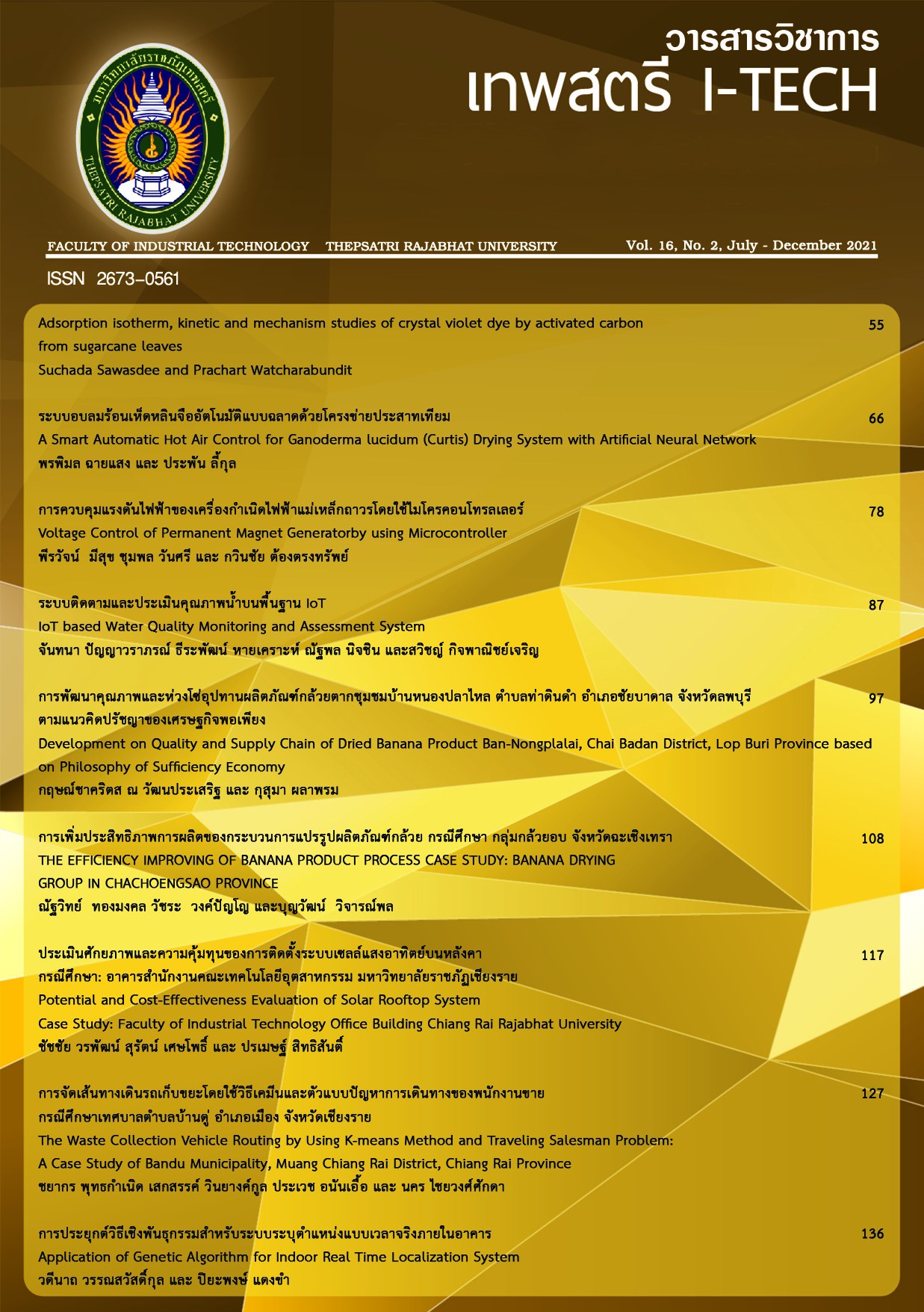ระบบอบลมร้อนเห็ดหลินจืออัตโนมัติแบบฉลาดด้วยโครงข่ายประสาทเทียม
Abstract
บทความนี้นำเสนอระบบควบคุมการอบแห้งด้วยลมร้อนแบบฉลาดด้วยการประยุกต์ใช้โครงข่ายประสาทเทียมในการตัดสินใจ เพื่อควบคุมระดับอุณหภูมิในการอบแห้งเห็ดหลินจือแบบอัตโนมัติ ระบบประกอบด้วย ส่วนตรวจวัดอุณหภูมิส่วนประมวลผลและส่วนควบคุมมอเตอร์ อุณหภูมิในตู้อบลมร้อนถูกตรวจวัดด้วยเทอร์โมคลัปเปิล Type K และถูกแปลงเป็นสัญญาณดิจิทัลด้วยวงจร MAX6675 พร้อมเทียบกับเวลาจริงที่ใช้ในการอบแห้งด้วยโมดูล DS1302 ข้อมูลเวลาและอุณหภูมิได้รับการแสดงผลบนหน้าจอ OLED และข้อมูลยังได้รับการวิเคราะห์จากโครงข่ายประสาทเทียมที่ใช้อินพุต 2 โนด โนดซ่อนเร้น 4 โนด และให้เอาต์พุตที่เป็นตัวแทนของอุณหภูมิในแต่ละช่วงเวลา 3 โนด ใช้อัตราการเรียนรู้ 0.1 ให้ค่าความผิดพลาด 0.488 และให้ความแม่นยำ 100% ข้อมูลการตัดสินใจถูกส่งไปยังส่วนควบคุมมอเตอร์ด้วยการสื่อสารผ่านบลูทูธ ส่วนควบคุมทำหน้าที่รับข้อมูลและเปลี่ยนเป็นสัญญาณควบคุม จากนั้นส่งต่อไปยังบอร์ดขับเพื่อควบคุมมอเตอร์สเต็ปเปอร์ให้หมุนวาล์วแก๊สในช่วง -40 ถึง +20 องศา เพื่อปรับระดับอุณหภูมิให้อยู่ในช่วง 50 60 และ 70 องศาเซลเซียส ที่เวลาน้อยกว่า 3 9 และ 18 ชั่วโมง ตามลำดับ ระบบได้รับการทดสอบทั้งหมด 3 ครั้ง แต่ละครั้งใช้ความถี่ในการตรวจวัดและควบคุม คือ ทุกๆ 2 5 และ 10 นาที ตลอดเวลาการอบแห้งที่ 18 ชั่วโมง ความถี่ในการตรวจวัดที่เหมาะสม คือ 5 นาที เนื่องจากประหยัดพลังงานและควบคุมอุณหภูมิให้อยู่ในช่วงที่ต้องการได้อย่างเหมาะสม มีความคลาดเคลื่อนเพียง ±2.9 องศาเซลเซียส แสดงให้เห็นว่าระบบควบคุมการอบแห้งเห็ดหลินจือด้วยลมร้อนอัตโนมัติทำงานได้อย่างมีประสิทธิภาพ
References
Mohamad Ansor, N. Abdullah N. and Aminudin, N. “Anti-angiotensin converting enzyme (ACE) proteins from mycelia of Ganoderma lucidum (Curtis) P. Karst,” BMC Complementary and Alternative Medicine, vol. 13 no.256, pp. 1-8, 2013.
Chin, S. K. Law, C. L. and Cheng, P. G. “Effect of drying on crude ganoderic acides and water-soluble polysaccharides content in Ganoderma lucidum,” International Journal of Pharmacy and Pharmaceutical Sciences, vol. 3, no.1, pp. 38-43, 2011.
Bijalwan, A. Bahuguna, K. Vasishth, A. Singh, A. [Alankar], Chaudhary, S. Tyagi, A. Thakur, M.P. Thakur, T.K. Dobriyal, M. JR. Kaushal, R. Singh, A. [Arjun], Maithani, N. Kumar, D. Kothari, G. and Chourasia, P.K. “Insights of medicinal mushroom (Ganoderma lucidum): prospects and potential in India,” Biodiversity International Journal, vol.4, no.5, pp. 202-209, 2020.
Hennicke, F. Cheikh-Ali, Z., Liebisch, T. Maciá-Vicente, J.G. Bode, H.B. and Piepenbring M. “Distinguishing commercially grown Ganoderma lucidum from Ganoderma lingzhi from Europe and East Asia on the basis of morphology, molecular phylogeny, and triterpenic acid profiles,” Phytochemistry, vol.127, pp. 29-37, 2016.
Persistence Market Research. Medicinal mushrooms market: global industry trend analysis 2013 to 2017 and forecast 2018 – 2028. [Online]. (2018). [Cited January 9, 2021] https://www.persistencemarketresearch.com/market-research/medicinal-mushrooms-market.asp.
Hapuarachchi, K. K. Elkhateeb, W. A. Karunarathna, S. C. Bandara, A. R. Kakumyan, P. Hyde, K. D. Daba, G. M. Cheng, C. R. and Wen, T.C. “Current status of global Ganoderma cultivation, products, industry and market,” Mycosphere, vol. 9, no.5, pp. 1025-1052, 2018.
Barbosa, J. Borges, S., Amorim, M. Pereira, M. J., Oliveira, A., Pintado, M.E. and Teixeira, P. “Comparison of spray drying, freeze drying and convective hot air drying for the production of a probiotic orange powder,” Journal of Functional Foods, vol. 17, pp. 340-351, 2015.
Dehghannya, J., Hosseinlar, S.H. and Heshmati, M.K. “Multi-stage continuous and intermittent microwave drying of quince fruit coupled with osmotic dehydration and low temperature hot air drying,” Innovative Food Science and Emerging Technologies, vol. 45, pp.132–151, 2018.
Zhao, R. & Gao, T. “Research progress of hot air drying technology for fruits and v egetables,” Advance Journal of Food Science and Technology, vol.10, no.3, pp.160-166, 2016.
Argyropoulos, D. Heindl, A. and Mũller, J. “Assessment of convection, hot-air combined with microwave-vacuum and freeze-drying methods for mushrooms with regard to product quality,” International Journal of Food Science and Technology, vol.46, pp. 333–342, 2011.
Kotwaliwale, N. Bakane, P. and Verma, A. “Changes in textural and optical properties of oyster mushroom during hot air drying,” Journal of Food Engineering, vol. 78, no.4, pp. 1207-1211, 2007.
Tulek, Y. “Drying kinetics of Oyster mushroom (Pleurotus ostreatus) in a convective hot air dryer,” Journal of Agricultural Science and Technology, vol.13, pp. 655-664, 2011.
Prasetyo, D.J. Jatmiko, T.H. Poeloengasih, C.D. and Kismurtono, M. “Drying characteristics and water-soluble polysaccharides evaluation of kidney shape Ganoderma lucidum drying in air circulation system,” Conf. Series: Earth and Environmental Science, vol. 101, pp. 1-6, 2017.
Nuangpirom, P. Techapunratanakul, N. Panta, S. Maneewan, D. and Chitanu, K. “Potential development and capacity building for mushroom product processing: case study of Sukprasert mushroom farm,” Journal of Socially Engaged Scholarship, vol. 2, no. 2, pp. 41- 51, 2018 (in Thai).
Qinghui, W. Zhongxin, L. Jinsong, Y. Long, X. Shixiang, Z. and Zhenjiang, G. “Dried characteristics of cherry tomatoes using temperature and humidity by stages changed hot-air drying method,” Transactions of the Chinese Society of Agricultural Engineering, vol. 30, no.3, pp.271-276, 2014.
Chiangmainews, 108 Properties of reishi mushroom, Maejo University can do. [Online]. (2016). [Cited January 25, 2021] https://www.chiangmainews.co.th/page/ archives/ 524604 (in Thai).
Binder. (2019). Model FD 56 | drying and heating chambers with forced convection, Data Sheet.
Rerkkumsup, P. Yaruan, P. and Soeatuptim, J. “The Development of an Automatic Control System for Charcoal Briquettes Drying,” Pathumwan Academic Journal, vol. 10, no. 27, pp.70 - 83, January - April 2020 (in Thai).
Leekul, P. and Limpiti, T. “Development of C-band monopole antenna with artificial neural networks cooperation for latex contamination detecting application,” Journal of Industrial Technology: Suan Sunandha Rajabhat University, vol. 7, no. 2, pp.24-33, 2019 (in Thai).
Leekul, P. Wongsiritorn, P. and Chaisaeng, P. “Development of humidity monitoring system in greenhouse with electromagnetic X- band and artificial neural networks,” Progress In Electromagnetics Research M, vol.100, pp. 93-103, 2021,
Leekul, P. Soontornwong, P. and Chivapreecha, S. “Low complexity artificial neural network unit for sugar content detection in microwave sensor system,” Signal and Information Processing Association Annual Summit and Conference (APSIPA), Siem Reap, Cambodia, December 9-12, 2014.
Haykin, S. Neural networks and learning machines (3rd edition), Pearson, London, United Kingdom, 2008.
Leekul, P. “Application of artificial neural network for milk quality classification with dielectric properties,” Journal of Industrial Technology: I-Tech, vol. 12, no, 2, pp,131-140, 2017 (in Thai).

